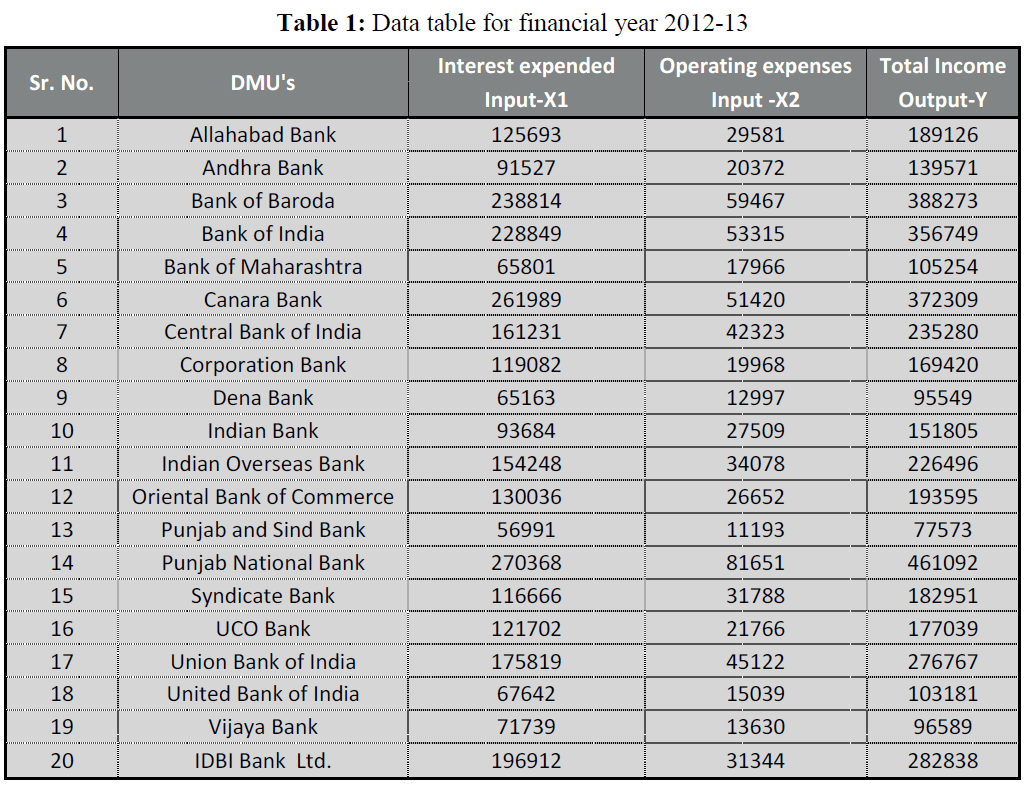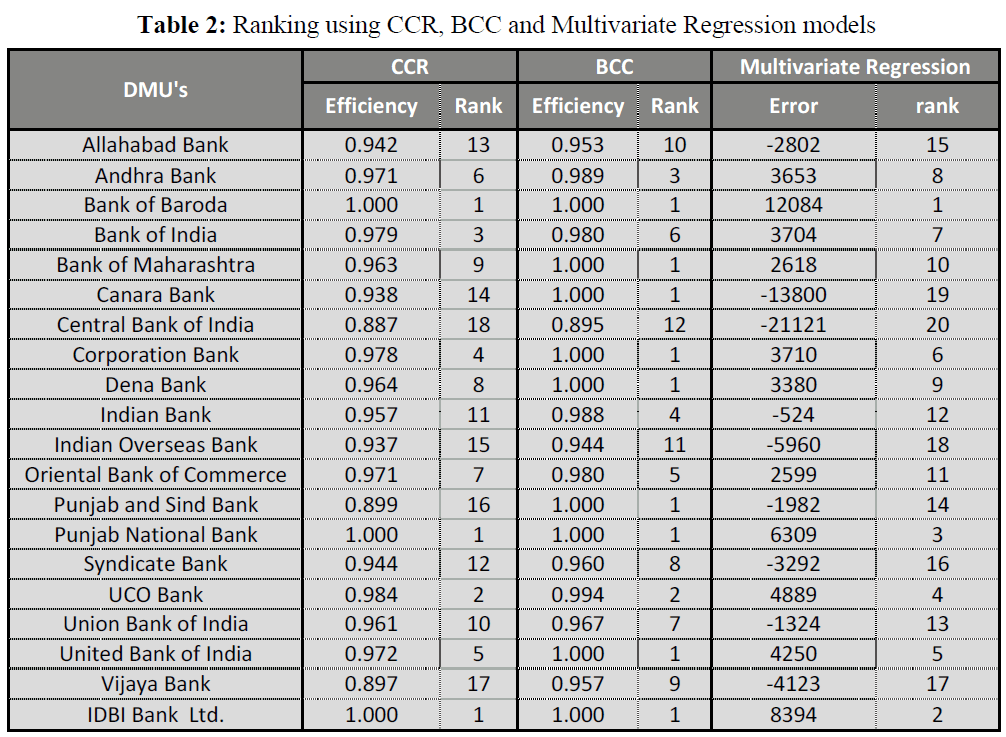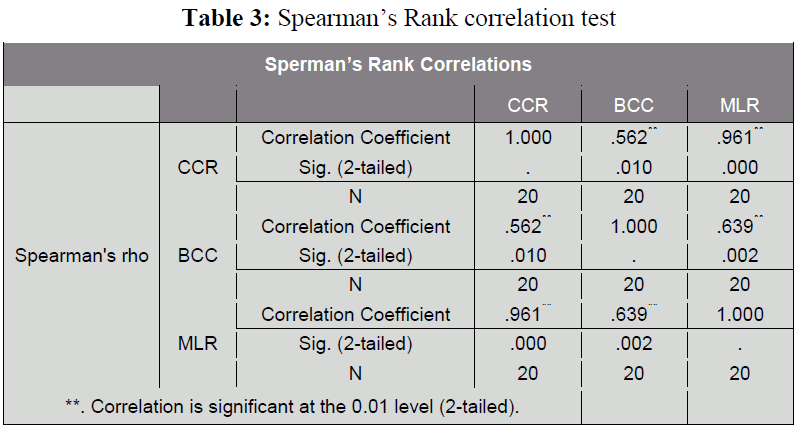Keywords
Linear Programming Problem, Data Envelopment Analysis, Multivariate Regression
Analysis, Indian Banking.
Introduction
Indian banking sector is one of the
largest banking system in the world. Indian
banking system is mainly divided into
Public Sector Banks and Private Sector Banks. The Public Sector Banks are further
divided into two categories as Nationalised
Banks and SBI group banks and Private
Sector Banks are divided into Foreign Banks and Domestic Private Banks. The
Nationalised Banks in India play the pivotal
role of Indian economy. The major market
has been captured through Nationalised
Banks. Our research has major focus on to
improve efficiencies and effectives of
Nationalised Banks of India. The purpose of
this paper is to propose a hybrid
methodology based on Data Envelopment
Analysis (DEA) and Statistical Regression
analysis that addresses to this issue of
efficiency using data from Nationalised
Indian banks.
Over the past two decades, data
envelopment analysis (DEA) has become a
popular methodology for evaluating the
relative efficiencies of decision making units
(DMUs), many researches has been
chosenbanks are decision making units.
They have proved the different DEA models
are useful for efficiency measurement of
banks andits target setting. Data
Envelopment Analysis is an approach to
estimate the production function of
organizations and organizational units and
enables the assessment of their efficiency.
The comparison of empirical results
produced by DEA and Multivariate
Regression Analysis is still uncommon in
bank efficiency literature. Multivariate
Regression Analysis is useful tool to predict
the independent value of variable from one
and more than one dependent variable.
Regression analysis is a statistical tool that
is used to investigate the relationship
between variables. It is a parametric
technique that requires the specification of a
production function.
DEA provides an estimation of the
production function to which each
individual Decision Making Unit’s (DMU’s)
efficiency score can be compared.
Furthermore, DEA offers a number of
advantages over traditional techniques
including its ability to identify reference
units for each DMU. These characteristics prove to be a very useful managerial tool as
it aids in establishing potential causes and
methods of improvement for the identified
inefficient.
Literature review
Data Envelopment Analysis (DEA)
is a linear programming technique to assess
the efficiencies of decision making units
(DMU) when multiple variables are taken
into account. Literature related to efficiency
studies can be traced back to Farrell [4], who
treated the production frontier as the basis
for efficiency assessment. The Charnes,
Cooper and Rhodes (CCR)1described a
mathematical programming formulation for
the empirical evaluation of relative
efficiency of a Decision Making Unit
(DMU) on the basis of the observed
quantities of inputs and outputs for a group
of similar referent DMUs. The Banker,
Charnes and Cooper (BCC) [6] provideda
formal link between DEA and estimation
ofefficient production frontiers via
constructs employedin production
economics. Satye [10] used DEA to study the
relative efficiency of Indian banks in the late
1990’s with that of banks operating in other
countries. He found that the public sector
banks have a higher mean efficiency score
as compared to the private sector banks in
India, but found mixed results when
comparing public sector banks and foreign
commercial banks in India. Kumbhakar and
Sarkar [11] estimated the cost efficiency of
public and private sector banks in India by
using the stochastic cost frontier model with
specification of translog cost function.
The Seiford and Zhu [8] examined the
performance of the top 55 US banks using a
two-stage DEA approach. Results indicated
that relatively large banks exhibit better
performance on profitability, whereas
smaller banks tend to perform better with
respect to marketability. Drake and
Howcroft [12] assessed the relative efficiency of UK clearing bank branches using DEA
method. This paper utilized the basic
efficiency indices and extended the analysis
by examining the relationship between size
and efficiency. Many of these studies find
that state-owned banks are more efficient
than private and foreign banks
(Bhattacharyya and Pal [19]; Sharma [20]), find
that foreign banks are actually the most
efficient. R. Kiani Mavi [17] estimated the
ranking of banks branches using DEA and
multivariate regression analysis, results
indicate that the efficiency calculated from
CCR model and multivariate regression
model has positively correlated.
Premachandra [21] examine the capability of
DEA in assessing corporate bankruptcy by
comparing it with logistic regression
(LR).The main objective of this paper to
assesses efficiency of Indian banks using
DEA technique and Multivariate Regression
Analysis techniques.
Material and Methods
Data Envelopment Analysis
Data has been collected from RBI
website for evaluation. Data Envelopment
Analysis is a linear programming procedure
for a frontier analysis of inputs and outputs.
The input-oriented DEA model under the
assumption of constant return to scale
&variable return to scale can be used for
calculation of input-oriented technical
efficiency. In this study, we estimate the
CCR model proposed by Charnes et al.
(1978) and BCC model proposed by Banker
et al. (1984), which allows for variable
returns to scale. The input-oriented CRS
&VRS model can be written as:
The basic input-oriented CRS model
for ‘n’ DMUs with ‘m’ inputs and ‘s’
outputs proposed by CCR, the relative
efficiency score of pth DMUs is given by
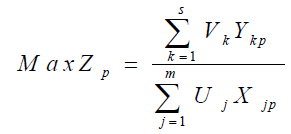
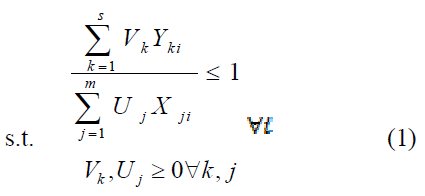
Where, k = 1 to s (number of outputs);
j = 1 to m (number of inputs);
i = 1 to n (number of DMUs);
Yki = amount of output k produced by DMU i;
Xji = amount of input j utilized by
DMU i;
Vk = weight given to output k and Uj = weight given to input j.
The fractional programme shown in
Equation (1) can be reduced to LPP as
follows:



This model is called CCR inputoriented
DEA model. The efficiency score
of ‘n’ DMUs is obtained by running the
above LPP ‘n’ times.
Multivariate Regression Analysis
The Multivariate linear regression
model can be return in below form

Where Y is the dependent variable
and  is the ith independent
variable. Therefore
is the ith independent
variable. Therefore  is the
coefficient of
is the
coefficient of  a is constant and
a is constant and is the
estimation error term.
is the
estimation error term.
Results and Discussion
In this paper, we have analyzed
efficiency of Indian Banks using hybrid
approach of DEA and Regression analysis.
In this paper, we have taken data of 20
Nationalised Indian Banks during financial
year of 2012-13. We have used two input
measure such as interest expended (X1),
operating expenses (Y2) and one output
measure as total income (Y) (total income is
summation of Interest income and other
income). Data has been collected from RBI
website for the financial year 2012-13.
Table 1: Data table for financial year 2012-13
In this paper, we have used the inputorientation
CCR model, input-orientation
BCC model of DEA and Multivariate
Regression analysis model to evaluate
performance measurement of Nationalised
Banks and also comparative study on
parametric and non-parametric techniques.
We have applied Spearman’s rank
correlation test to testing the result obtained
from CCR, BCC and Multivariate
regression.
The table 2 shows efficiency and
ranking of each bank using input oriented
CCR model and input oriented BCC model,
last column show ranking obtained through
Multiple regression analysis. The both CCR
and BCC result indicates that Bank of
Baroda, Punjab National Bank and IDBI
Bank Ltd. are efficient frontier and their
ranks are one. Other than these three banks,
efficient frontier banks using BCC model
are Bank of Maharashtra, Canara Bank,
Corporation Bank, Dena Bank, Punjab and
Sind Bank, and United Bank of India. The remaining banks are inefficient and their
scores are less than one. The CCR and BCC
efficiency score of DMUs are calculated by
using R Software and detail result has
shown in CCR & BCC columns of Table 2.
Table 2: Ranking using CCR, BCC and Multivariate Regression models
We have used multivariate
regression model for this data, then the
linear regression equation as:
Y=-5688+1.11X1+1.964X2+ 
Error of estimation can be computed
by subtracting Y from the actual amount of
the output variable (income) for each DMU.
DMUs are ranked based on descending
error. The results are shown in last two
columns of Table 2. The Multiple regression
result indicates that the Bank of Baroda is
topper bank out of these banks and its rank
is one. The IDBI Bank Ltd and Punjab
National Bank are getting second and third
rank respectively.
The below descriptive Statistics
summary show overall Nationalised Banks
efficiency obtained through input oriented
Constant Return to Scale model of DEA.
Result indicates that out of 20 banks only
three banks are efficient and having score
one.
Descriptive Statistics Summary of Overall
Banks using CCR model using R software-
>summary(e)
Summary of efficiencies
The technology is crs and input
orientated efficiency
Number of firms with efficiency==1
are 3
Mean efficiency: 0.957
Eff range # %
0.8<= E <0.9 3 15
0.9<= E <1 14 70
E ==1 3 15
Min.1st Qu.Median Mean 3rd Qu. Max.
0.8865 0.9412 0.9632 0.9572 0.9785 1.0000
The below descriptive Statistics
summary show overall Nationalised Banks
efficiency obtained through input oriented
Variable Return to Scale model of DEA.
Result indicates that out of 20 banks, nine
banks are efficient (i.e.45% banks
distribution data covered) and having score
one.
Descriptive Statistics Summary of Overall
Banks using BCC model using R software
>summary(e)
Summary of efficiencies
The technology is vrs and input
orientated efficiency
Number of firms with efficiency==1 are 9
Mean efficiency: 0.98
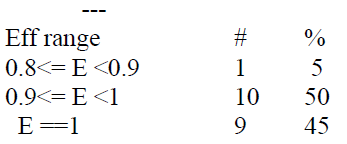
Min.1st Qu.Median Mean 3rd Qu. Max.
0.8952 0.9654 0.9917 0.9803 1.0000 1.0000
The below Spearman’s rank
correlation test result show, it has applied
for testing comparison between rank
obtained through CCR model, BCC model
and Multiple Regression model. Result
indicates that CCR model and Multivariate
regression model are positively correlated
with each other and its correlation is
0.961.Also result indicates that Multiple
regression and BCC model of DEA are
positively correlated with each other but as
compare to CCR model are less correlated.
See table no. 3
Table 3: Spearman’s Rank correlation test
Conclusion
This paper presents a unique
approach of DEA &Multivariate Regression
Analysis for evaluating Indian banks
performance. We have considered group of
Nationalised Indian Banks (i.e. 20 banks), it
has been analyzed for effectiveness using
DEA & Multivariate Regression Analysis.
We have investigated the performance of
Indian banks by using input orientated CCR,
BCC based DEA model &Multivariate
Regression Analysis (Result has been shown
in table 2). The result shown that the Bank
of Baroda, IDBI banks ltd and Punjab
National Banks has most efficient. We have
tested and verify the relative efficiency
results of CCR model, BCC model and
Multivariate regression model using nonparametric
Spearman rank test. The results
show that there is positively and
significantly correlated between the set of
rankings. This study provides scope for
further research using larger input sample
size to test the robustness of the results.
References
- Charnes, A., Cooper, W.W. and Rhodes, E. (1978), “Measuring the efficiency of decision making units”, European Journal of Operations Research, 2: 429- 444.
- Collier, T., Johnson, A.L. and Ruggiero, J. (2011) ‘Technical efficiency estimation with multiple inputs and multiple outputs using regression analysis’, European Journal of Operational Research, Vol. 208, No. 2, pp.153–160.
- Aigner, D.J., C.A.K. Love11 and P. Schmidt, 1977, Formulation and estimation of stochastic frontier production function models, Journal of Econometrics 6, 21-37.
- Farrel, M.J., 1957, the measurement of productive efficiency, Journal of the Royal Statistical Society A 70, 253-281.
- Cooper, W.W., Seiford, L.M. and Tone, K. (2000) Data envelopment Analysis, Boston: Kluwer.
- Banker, R., Charnes, A., & Cooper, W. (1984). Some models for estimating technical and scale inefficiencies in data envelopment analysis. Management Science, 30, 1078–1092.
- Wang, N. S., Yi, R. H., & Wang, W. (2008). Evaluating the performances of decision making units based on interval efficiencies. Journal of Computational and Applied Mathematics, 216, 328– 343.
- Seiford, L., & Zhu, J. (1999). Profitability and marketability of the top 55 US commercial banks. Management Science, 45, 1270–1288.
- Sengupta, J. (1995). Dynamics of data envelopment analysis: Theory of systems efficiency. Boston, MA: Kluwer Academic Publishers.
- Satye. M, (2003). Efficiency of Banks in developing Economy. The case of India. European Journal of Operational Research. 148(3). 662-671.
- Kumbhakar. S.C. and Sarkar, S. (2004). Deregulation, Ownership and Efficiency in Indian Banking: An application of Stochastic Frontier Analysis. IGIDD working paper. Available at: www.igidr.ac.in/conf/finwrk/workshop.p df.
- Drake, L., & Howcroft, B. (2002). An insight into the size efficiency of a UK bank branch network. Managerial Finance, 28, 24–36.
- Sun, S., & Lu, W. (2005). Evaluating the performance of the Taiwanese hotel industry using a weight slacks-based measure. Asia-Pacific Journal of Operational Research, 22, 487–512.
- Bogetoft, Peter and Lars Otto (2013), Benchmarking with DEA and SFA, R package version 0.23.
- Coelli, T. J., D. S. P. Rao, C. J. O'Donnell and G. E. Battese (2005). An Introduction to Efficiency and Productivity Analysis. Second ed. New York: Springer.
- Kumbhakar, S. C., S. Ghosh and J. T. McGuckin (1991). "A Generalized Production Frontier Approach for Estimating Determinants of Inefficiency in U.S. Dairy Farms." Journal of Business and Economic Statistics 9, 279- 286.
- R.Kiani Mavi et al. (2015), Ranking banks branches using DEA and multivariate regression models. Int. J. Operational Research, 24, 245-261.
- Ataullah, A. and Le, H. (2008) ‘Economic reforms and bank efficiency in developing countries: the case of the Indian banking industry’, Applied Financial Economics, Vol. 16, No. 9, pp.653–663.
- Bhattacharyya and S. Pal. (2013). Financial reforms and technical efficiency in Indian commercial banking: A generalized stochastic frontier analysis. Review of Financial Economics, 22(3):109–117.
- S.Sharma, D. Raina, and S. Singh. (2012) Measurement of technical efficiency and its sources: An experience of Indian banking sector. Journal of Economics and Management, 6: 35–57.
- Premachandra, I.M., Bhabra, G.S. and Sueyoshi, T. (2009) ‘DEA as a tool for bankruptcy assessment: a comparative study with logistic regression technique’, European Journal of Operational Research, Vol. 193, No. 2, pp.412–424.
- E. Thanassoulis. (1993). A Comparison of Regression Analysis and Data Envelopment Analysis as Alternative Methods for Performance Assessments, the Journal of the Operations Research Society, Vol. 44, No. 11, pp. 1129-1144.
- Kooreman P. (1994). Data envelopment analysis and parametric frontier estimation: Complementary tools, Journal of Health Economics, 13: 345- 46.
- Cooper, W.W., Tone, K., 1997. Measures of inefficiency in data envelopment analysis and stochastic frontier estimation. European Journal of Operational Research 99, 72–88.
- Friedman, L., Sinuany-Stern, Z., 1997. Scaling units via the canonical correlation analysis and the data envelopment analysis. European Journal of Operational Research 100 (3), 629– 637.
- Sinuany-Stern, Z., Friedman, L., 1998. Data envelopment analysis and the discriminant analysis of ratios for ranking units. European Journal of Operational Research 111, 470– 478.
- Azadeh, A., Seraj, O., Asadzadeh, S.M. and Saberi, M. (2012). An integrated fuzzy regression-data envelopment analysis algorithm for optimum oil consumption estimation with ambiguous data’, Applied Soft Computing, Vol. 12, No. 8, pp.2614–2630.
- Banker, R., Gadh, V.M. and Gorr, W. (1993). A Monte Carlo comparison of two production frontier estimation methods: corrected ordinary least squares and data envelopment analysis’, European Journal of Operational Research, Vol. 67, No. 3, pp.332–343.
- Coelli, T. and Perelman, S. (1999). A comparison of parametric and nonparametric distance functions: with application to European railways’, European Journal of Operational Research, Vol. 117, No. 2, pp.326–339.
- Collier, T., Johnson, A.L. and Ruggiero, J. (2011). Technical efficiency estimation with multiple inputs and multiple outputs using regression analysis’, European Journal of Operational Research, Vol. 208, No. 2, pp.153–160.
- Ifeagwu E.N., Ogu. C.J. and Alagbu E. (2015). Enhancing the performance of wideband code division multiple access (WCDMA) network using antenna diversity technique, American Journal of Computer Science and Information Technology, Vol.3,No.1, pp.014-25.
- Das, A. and Ghosh, S. (2009). Financial deregulation and profit efficiency: a nonparametric analysis of Indian banks’, Journal of Economics and Business, Vol. 61, No. 6, pp.509–528.
- Premachandra, I.M., Bhabra, G.S. and Sueyoshi, T. (2009). DEA as a tool for bankruptcy assessment: a comparative study with logistic regression technique’, European Journal of Operational Research, Vol. 193, No. 2, pp.412–424.
- Wang, Y.M., Luo, Y. and Lan, Y.X. (2011) ‘Common weights for fully ranking decision making units by regression analysis’, Expert Systems with Applications, Vol. 38, No. 8, pp.9122–9128.







 is the ith independent
variable. Therefore
is the ith independent
variable. Therefore  is the
coefficient of
is the
coefficient of  a is constant and
a is constant and is the
estimation error term.
is the
estimation error term.